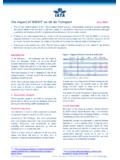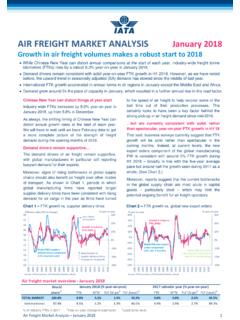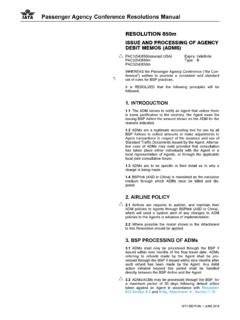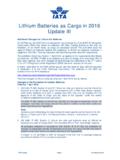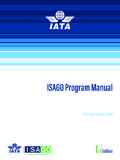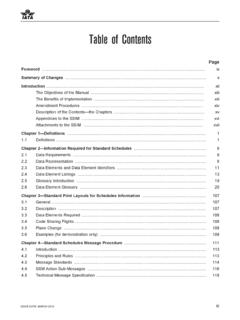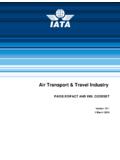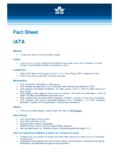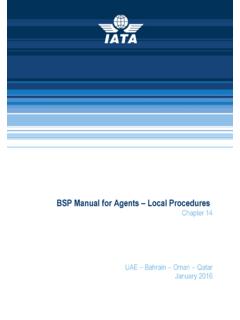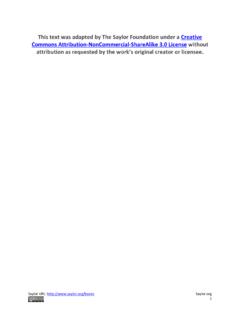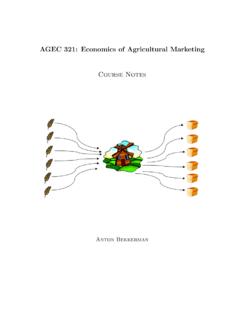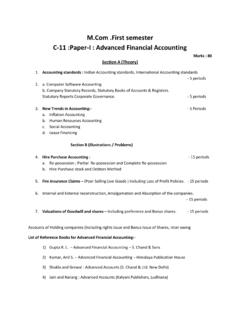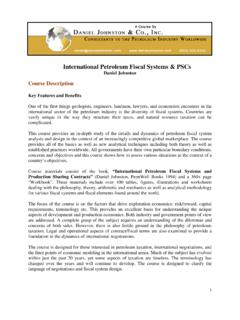Transcription of A Lessor’s Perspective of Maintenance Reserve …
1 basics of Aircraft Maintenance Reserve Development and Management A Lessor's Perspective of Maintenance Reserve Theory and Best Practices By: Shannon Ackert Abstract The importance of Maintenance reserves to protecting asset value is a key consideration of lessors. In an ideal situation, the reserves plus the residual condition of select high cost Maintenance events would essentially keep the economic condition of the aircraft whole. Maintenance reserves serve as a mechanism to mitigate credit risk and therefore are generally imposed on weaker credit airlines. However, in the event a lessee negotiates to not pay Maintenance reserves they may still be required to provide collateral security in the form of an end of lease financial adjustment or through a Letter of Credit (LOC).
2 These reserves are, in turn, based on the industry norm for that aircraft type, or in the case of a new aircraft, based on manufacturers' recommendations. Maintenance reserves are often the most contentious part of a lease negotiation; the lessor views reserves as a cost-covering exercise, while the lessee views it as a burden on their cash flow resources. Often undervalued as a discipline, an understanding of Maintenance reserves is critical to gaining a Perspective on the risk and rewards of aircraft leasing. basics of Aircraft Maintenance Reserve Development & Management TABLE OF CONTENTS. 1. INTRODUCTION .. 2. 2. SOURCES OF Maintenance DATA . 4. 3. Maintenance Reserve ECONOMICS.
3 5. Airframe Maintenance Economics .. 6. Landing Gear Maintenance Economics .. 7. Engine Maintenance Economics .. 11. Engine Module Maintenance Economics .. 12. Engine LLP Maintenance Economics .. 16. APU Maintenance Economics .. 17. Maintenance Reserve for Equipment with no Maintenance History 19. 4. Maintenance Reserve CONTRACT MANAGEMENT .. 20. Definitions & Interpretations .. 20. Maintenance Reserve Notional Accounts Development & Management .. 21. Maintenance Reserve Coverage and Exposure . 22. Modeling of Maintenance Reserve Rates .. 23. Maintenance Reserve Cash Flow Forecasting .. 24. Maintenance Reserve Cost-Sharing .. 27. Maintenance Inflation .. 28. APPENDIX A: Maintenance UTILITY.
4 29. APPENDIX B: EXAMPLE MAINTEANCE Reserve NOTIONAL ACCOUNT LEDGER .. 30. APPENDIX C: EXAMPLE MAINTEANCE Reserve LETTER OF INTENT LANGUAGE . 31. APPENDIX D: Maintenance COSTS, INTERVALS & Reserve RATES .. 32. REFERENCES .. 34. 1 Version / August 2012 | Aircraft Monitor basics of Aircraft Maintenance Reserve Development & Management 1. INTRODUCTION. Most operating leases provide that the lessee is liable for the ongoing costs related to maintaining an aircraft to the required standard. In the event that an aircraft is forcibly repossessed due to a default by the airline, the aircraft may require expensive investment in outstanding Maintenance work before it is in a condition to be re-leased or sold to another airline/investor.
5 Therefore, a lessor's primary risk in relation to Maintenance is one where the lessee fails to pay, in whole or in part, for the Maintenance utility they consumed. To mitigate Maintenance exposure most lessors have independent credit departments to evaluate the creditworthiness of lessees. Evaluation of an operator's credit standing generally involves the establishment of some financial test, the failure to meet which would invoke an obligation to establish more stringent collateral security in the form of security deposits and payment of Maintenance reserves. Maintenance reserves are payments made by the lessee to the lessor to accrue for those scheduled major Maintenance events that require significant aircraft grounding time and/or turn-around time for certain major component overhauls.
6 Put another way, Maintenance reserves are payments for Maintenance utility consumed and can be expressed as follows for a particular Maintenance event: Mx Reserves = Mx Utility Consumed OR Mx Reserves = Full-Life Mx Value Mx Utility Remaining A lease agreement will specify what Maintenance events are to be covered through payment of reserves and for which the lessee may draw down against the accrued amounts. Areas of Maintenance typically covered by reserves are as follows: Airframe Heavy Structural Inspections Landing Gear Overhauls Engine Performance Restoration Engine Life Limited Parts (LLPs). Auxiliary Power Unit (APU) Restoration The contractual position relating to Maintenance Reserve is always a subject of intense negotiation.
7 Many airlines have sufficient credit stature that their prominence in the marketplace means they can reject paying Maintenance reserves. On the other hand, lessors will show less flexibility for weaker credit lessees and require these operators to pay Maintenance reserves. Maintenance Reserve payments are calculated on flight hour, flight cycle, and/or calendar basis and are usually paid on a monthly basis in arrears. Accumulated reserves are reimbursed (subject to limitations). after major Maintenance events are completed. see Appendix A for summary of Maintenance Utility Aircraft Monitor | Version / August 2012 2. basics of Aircraft Maintenance Reserve Development & Management Therefore, at the time an aircraft is taken out of service for Maintenance , the lessor should already have funds to cover the cost of outstanding Maintenance .
8 More importantly, in the event of default, Maintenance Reserve provides lessor with value protection throughout the lease. In general, reserves become the property of the lessor immediately upon payment. Customarily, the lessee will cause the required Maintenance to be completed and then claim reimbursement for the qualified portion of the work from the Reserve account held by the lessor. Repayment takes place only if payment into the Reserve account is fully up to date, and only up to the amount held in the specific Reserve account. Thus if a particular event is carried out, and the cost of that work exceeds the total in the specific Reserve account, the excess cost is the responsibility of the lessee.
9 Funds generally cannot be transferred from other Reserve accounts for the same aircraft to cover any shortfall incurred. So, for example, a lessee cannot siphon a fund used for engine Maintenance and funnel those proceeds to subsidize the cost of airframe heavy check. In the event a lessee negotiates to not pay Maintenance reserves they may still be required to provide collateral security in the form of an End of Lease Financial Adjustment or through a Letter of Credit (LOC). Under an End of Lease Financial Adjustment structure, if a certain Maintenance event is returned at the end of a lease in a worse than stipulated condition, the lessee must make an end of lease payment to the lessor.
10 Conversely, if a certain Maintenance event is returned in a better than stipulated state, the lessor is obliged to pay the lessee. There are two types of end-of-lease payment structures: Mirror-In / Mirror-Out A mirror adjustment can either be one-way, where the Lessee is required to pay an adjustment when a certain Maintenance event is returned with less time remaining than at delivery, or a two-way mirror whereby lessor may have to pay the lessee if a certain Maintenance event is returned in better condition than at delivery. Zero-Time or Full-Life A payment whereby the lessor receives payment for time used since last overhaul or since new. A Maintenance Letter of Credit (LOC) is bank guarantee that lessee will return the asset to the lessor in the condition required by the lease.
